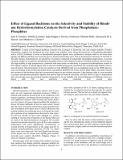Effect of ligand backbone on the selectivity and stability of rhodium hydroformylation catalysts derived from phospholane-phosphites
Abstract
A study on how ligand backbone structure has an impact on selectivity, rate, and catalyst stability of hydroformylation catalysts was prompted by some longer-term stability issues being discovered for a phospholane-phosphite with a [−CH2O−] backbone. A series of phospholane-phosphite ligands were synthesized. Catalysts made in situ from these ligands and [Rh(acac)(CO)2] were found to give iso-butanal selectivities up to 75% at temperatures between 75 and 105 °C: the latter being a benchmark for iso-selectivity in reactions conducted at industrially meaningful temperatures. A racemic rhodium complex of a bidentate phospholane-phosphite from a tropos-biphenol with an extended backbone showed unusually high stability at high temperatures, combined with even better iso-selectivity in propene hydroformylation relative to the original complex. A related ligand with an electron-withdrawing group maintained the unusually high stability and improved activity. Characterization of the precatalysts of type [RhH(CO)2(L)] was accomplished using in situ HPIR spectroscopy and backed up by density functional theory calculations (B3PW91-D3 level) and by NMR studies; the latter showed that the variation of the backbone also had a pronounced impact on the precatalyst structure. A key finding is that it is now possible to prepare phospholane-phosphite ligands that deliver high iso-butanal selectivity and that show no signs of degradation after several days even above typical reaction temperatures. In one stability test, several kilograms of aldehydes were produced with TOF and selectivity being consistent over several days.
Citation
Fuentes , J A , Janka , M E , Rodgers , J , Fontenot , K J , Bühl , M , Slawin , A M Z & Clarke , M L 2021 , ' Effect of ligand backbone on the selectivity and stability of rhodium hydroformylation catalysts derived from phospholane-phosphites ' , Organometallics , vol. Articles ASAP . https://doi.org/10.1021/acs.organomet.1c00540
Publication
Organometallics
Status
Peer reviewed
ISSN
0276-7333Type
Journal article
Description
We thank the Eastman Chemical Company for funding and permission to publish. M.B. thanks the School of Chemistry and EaStCHEM for support.Collections
Items in the St Andrews Research Repository are protected by copyright, with all rights reserved, unless otherwise indicated.

